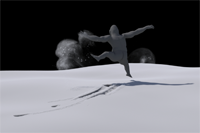
An Efficient Layered Simulation Workflow For Snow Imprints
François Dagenais, Jonathan Gagnon, and Eric Paquette,The Visual Computer, Volume 32, Number 6, pp 881–890, 2016.
 |
An Efficient Layered Simulation Workflow For Snow ImprintsFrançois Dagenais, Jonathan Gagnon, and Eric Paquette,The Visual Computer, Volume 32, Number 6, pp 881–890, 2016. |
This paper introduces a novel workflow to generate snow imprints, and model the interaction of snow with dynamic objects. We decoupled snow simulation into three components: a base layer, snow particles, and snow mist. The base layer consists of snow that has not been in contact with a dynamic object yet, and is stored as a level set. Snow particles model the interaction between the snow and the dynamic objects. They are added when the dynamic objects collide with the base layer, and are animated using an adapted granular material simulation. The very thin and powdery snow released by airborne snow particles is modeled by the snow mist. This component is greatly influenced by the surrounding air medium, thus it is animated using a fluid simulation. This decomposition allows to focus memory expensive and time-consuming computations only where dynamic objects interact with the snow, which is much more efficient than relying on a full-scale simulation.
@Article{Dagenais:2016:TVC,
author = "Fran{\c{c}}ois Dagenais and Jonathan Gagnon and Eric Paquette",
title = "An Efficient Layered Simulation Workflow For Snow Imprints",
journal = {The Visual Computer},
publisher = {Springer Berlin / Heidelberg},
pages = {accepted for publication},
volume = {32},
issue = {6-8},
year = {2016},
}
Pre-print version of the paper.
Pre-print version of the video:
